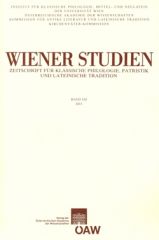
Wiener Studien 124/2011, pp. 279-295, 2011/11/07
Zeitschrift für Klassische Philologie, Patristik und lateinische Tradition

The late-antiquity libellus known as Cena Cypriani (Cena) represents an odd form of intellectual and perhaps convivial entertainment, wherein readers and listeners are made aware of biblical episodes through its story. Literarily, the Cena can be considered as a unique result arising from the mixture of Greek and Latin works from both the Classical era and Late Antiquity. Only during the Early Middle Ages, such work was attributed to Saint Cyprian and, for this reason, began circulating in the Carthaginian martyr’s body of writings. Nevertheless, the fate of this Early Medieval script is not connected solely to the auctoritas Cypriani. Indeed, the Cena circulated in the Carolingian scriptoria as disputatio, used as a means of teaching the Bible while also helping to amuse its readers and listeners. During Charles the Bald’s imperial coronation (875), the Cena was required to be read in Rome, where most likely it was unknown to the public. Subsequently, John Inmonides transformed the text into a well known rhythm composed for the convivial entertainment of the Carolingian sovereign and that of Pope John VIII.